Optimization has become something of a buzzword, not only recently but since digital marketing entered the business world. No wonder it’s so popular among small and large companies – the possibility to track and analyze undertaken actions sounds beyond fantastic.
Now, with unique automation systems that detect relevant data and provide you with filtered information, it’s even more accessible. However, choosing the right set of PR metrics might seem like cherry-picking.
? Read Digital PR Explained: Best Strategies and Tools
Let’s do it step by step, starting with the general idea and finishing with specific examples. Using PR metrics for your marketing advantage is easier than it may seem!
What are PR metrics, and why should you care?
Public relations goes hand in hand with digital marketing and needs modern solutions that can boost the overall performance and effectiveness of PR activities.
In the past, it was difficult to show the results of promotional campaigns as it was often hard to track them precisely. But now, the online world has finally armed marketers with tools that can help with PR measurement and optimization. By setting a list of such KPIs, you can gather data and analyze your company’s performance.
PR metrics, as the name suggests, relate precisely to the marketing field. They are worth tracking, as they give you both a bigger picture and the details about which campaigns are successful and what your competitors are doing.
With the right PR metrics, every company can know the nuts and bolts of their strategy, which projects work, and which don’t give them the desired ROI. That’s basically why PR metrics matter. They help you make the most of your brand by allowing you to interpret relevant data.
The benefits of tracking PR metrics
There are multiple reasons why PR metrics matter and should become an integral part of your marketing strategy. Let’s see what can you get from tracking them in a nutshell:
- Improved customer satisfaction. Your company runs thanks to the people who want to invest in what you have to offer. Listening to their needs and adjusting your brand to their expectations might leverage customer satisfaction and gain a loyal clientele.
- Decreased customer churn. It costs five times more to acquire new customers than to retain existing ones. Understanding your clients’ reasons for stopping using your services can help improve them and reduce churn.
- Provide a clear marketing ROI. Sometimes, it isn’t easy to convince the board to invest in marketing campaigns as there’s not enough evidence that such activities work well for the company. PR metrics are proof that some parts of the strategy are genuinely profitable.
- Compare the effectiveness of your campaigns. As stated above, you can analyze the data and conclude the efficiency of your marketing strategies. Thanks to PR metrics, you can clearly see the nuts and bolts of each campaign and optimize your actions accordingly.
- Compare the effectiveness of different platforms. You can compare not only single campaigns but also check which platforms work better for your business. There’s no point in investing in promotion on channels where the amount of feedback is insufficient. PR metrics can show you that, if you interpret them correctly. ?
Step one – build a steady foundation
There are various PR metrics one can follow, so the goal is to pick those that are relevant to your business. In this article, we’ll focus on the indicators essential for digital marketing, especially in terms of social listening and media monitoring.
What exactly can you track?
Before we get to the precise PR metrics, let’s start from scratch. To be fully informed and make sure you get all the necessary data concerning your business performance, you should consider tracking the following aspects:
- your company’s name
- brand name (and common misspellings)
- your product and services
- key people who are important to your company or industry
- your industry – for a general overview
- your competitors – keep your friends close and your enemies closer. ?
These form the basis of media monitoring that needs to be adjusted to your particular needs at any given moment. You can add more queries or specify existing ones in order to stay on top of news in your industry.
Quality over quantity – or why you shouldn’t track everything
They say you cannot have too much of a good thing. Maybe there’s some truth in that, but it doesn’t really apply to PR metrics and media monitoring.
The reason is simple. You can obtain too much information that is irrelevant, hard to compare, and problematic (if not impossible) to draw conclusions from. To get valuable data that can improve your actions and help you develop your business, you have to narrow down a few aspects and bet on quality.
Narrow down the number of queries
Speaking of PR metrics and queries – keep in mind that often quality is better than quantity. When it comes to the number of keywords you can enter, the sky’s the limit, but that doesn’t mean the more words you use, the better. Make sure to track only those you find relevant to your query instead, as a few carefully selected words can give you more valuable insights than a whole list.
So how many keywords should you use exactly? Based on our experience, thirty keywords per topic will do! Focusing on them can give you precise results, and what matters at the end of the day is quality.
Narrow down the number of languages you monitor
When you try to do something for everyone, you serve no one. Even if you run a business on an international market, you should pick only relevant languages.
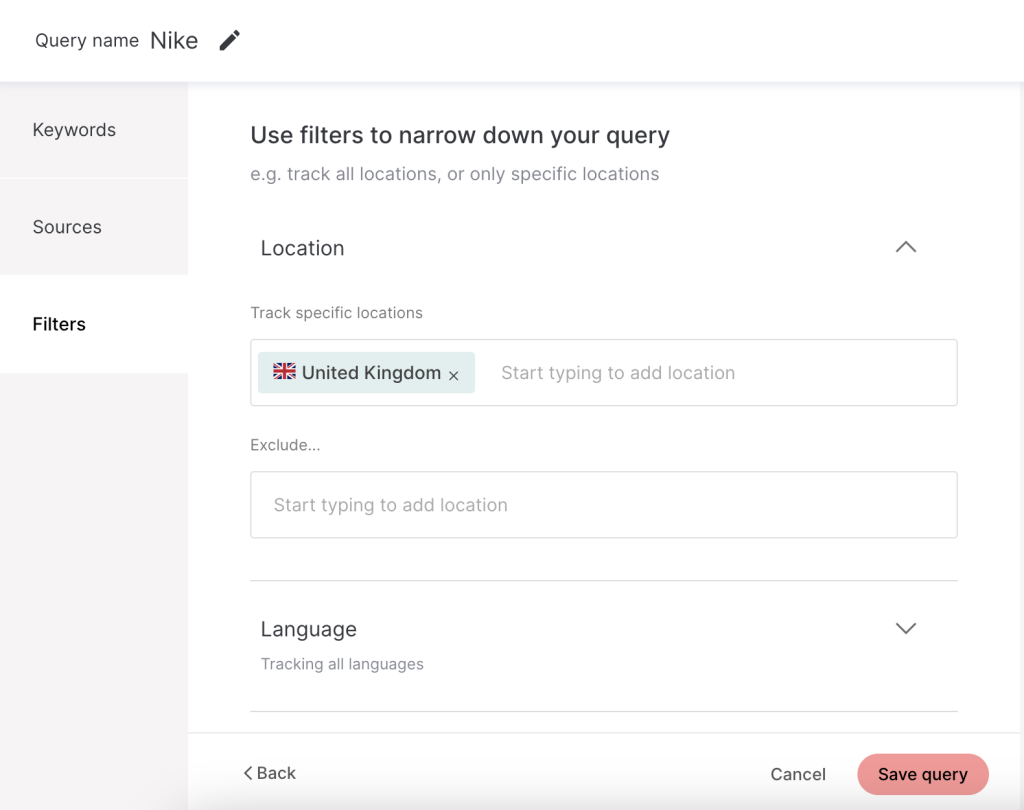
Plan in advance which languages to include and which need to be excluded. Without such a filter, you might end up with mentions in any language from around the world clogging up your feed. Keep in mind that the choice always depends on your specific needs, so choose those languages that give you value.
Exclude irrelevant terms to get the desired results
To keep it short and sweet: by excluding particular phrases, you can focus a search and connect various pieces of information to find exactly what you’re looking for. This can extend or narrow your search when combined with keywords to refine the results of a query.
You can use basic and advanced options to determine your query precisely. Some examples of Boolean operators you could use are: “or”, “and”, “and not.”
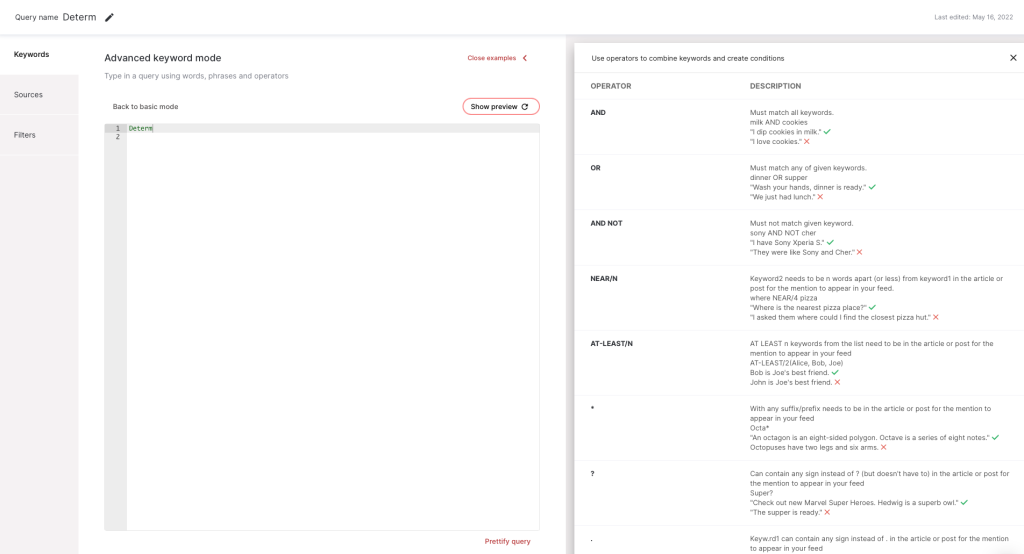
Suggested read: Explaining Boolean operators with pizza (infographic)
Now that you know which PR metrics aren’t worth tracking, it’s time to learn about those indicators you should follow!
6 must-use PR metrics for media monitoring
1) Mentions
If you want your digital actions to be effective, one of the PR metrics you should track is mentions. It’s important to note they’re not limited to social media only!

Mentions are online references that appear in any form of online content across channels such as social media, forums, and blogs. They’re about finding out when someone mentions one or more of the keywords online. They include your brand name or competitor’s name, as well as single products, people or even hashtags.
Importance of tracking mentions
There are over 4.2 billion social media users worldwide, and your task is to track each mention that anyone posts. It’s pretty impossible for a person to do this manually, so automation is vital for the job.
With systems such as Determ, you can find mentions of your brand even when a person doesn’t tag you in the post. And following the right mentions can provide value to your brand, as you can track your competition and reach any of their unsatisfied customers with your content to convert them into your clients by offering better services or products.
What’s more, once you set your keywords, you can compare them to a previous period to see how they’re performing over time and draw conclusions to improve your company’s strategy.
Suggested read: How to Efficiently Track Mentions Online
2) Sentiment
When you track your mentions, the raw information about your brand that appears in some message isn’t enough. You need to have more details to fully understand the context and apply corrections to your strategy.
Sentiment analysis is a PR metric you should keep an eye on, as it automatically interprets the emotions of people who talk about your brand on various channels. By knowing whether someone had positive, neutral, or negative thoughts about your company, you can draw conclusions and apply changes based on them.
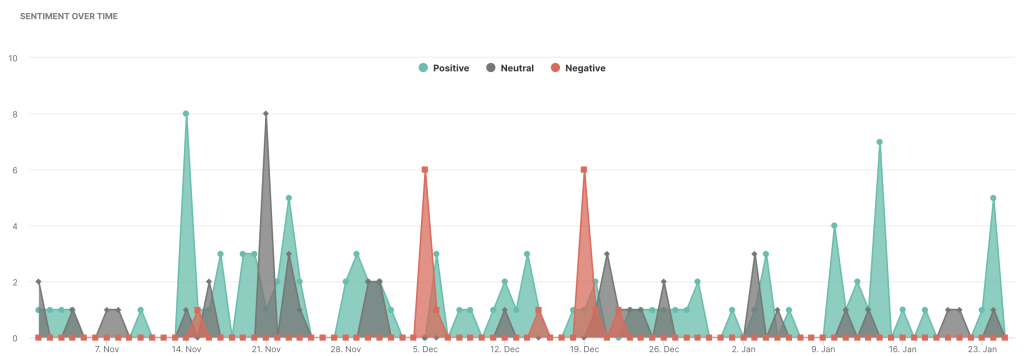
How sentiment provides value as a PR metric
You sell a tech product and a group of people comes across the same bug with it. They may write complaints about it on the internet and discourage others from purchasing.
If you track the sentiments metric, you can quickly respond to their issues and fix the pain point. Plus, if you follow it for a longer period of time, you can see whether these improvements work as planned.
To sum up, sentiment provides valuable insights into your customers’ wishes and needs, as well as helping measure the success or failure of your marketing efforts.
3) Share of voice
You’re probably familiar with this PR metric. In traditional media (print, TV, or radio) this metric used to describe the share of your advertising compared to all the competitors in your niche. The share of voice also acts as a measure of reach in digital marketing, but it shows the share of exposure for selected queries too.
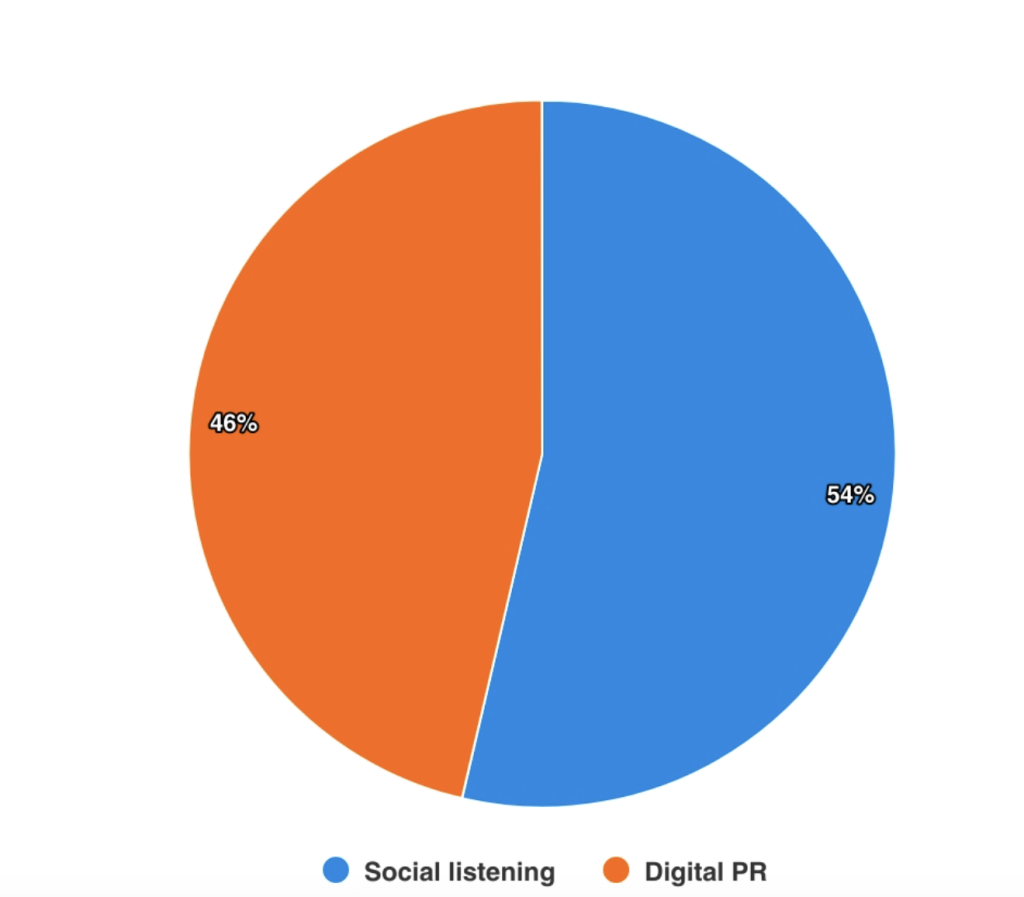
Using share of voice for competitor analysis
We know competition research comes back like a boomerang, but it’s one of the most significant aspects one should track with PR metrics. Let’s say you run a shoe shop and want to compare two or more brands to analyze how often (and where exactly) people speak about them. That’s what the share of voice is for!
This way, you can get a broader view of what actions other brands are taking and learn all about your company’s strengths and weaknesses. For easier data interpretation, information is visualized in the form of graphs – see how clearly it is shown here.
4) Website visitors
When monitoring PR metrics across digital channels, you’re looking for data generated by various types of users. As you do so, don’t look at your audience like a unified formation. All of these mentions come from unique individuals, and that’s how you should look at them. Every person and every client is different.
To know the whole spectrum of who’s talking about your brand, you can use media monitoring software to differentiate your audience into specific categories, for example: organic, returning, referral, unique, and those who used mobiles.
Why should you differentiate groups of visitors?
Someone mentions your brand’s name in answer to a Quora question. They might have different intentions when doing so, such as looking for the best media monitoring software provider or promoting your tool that they already use. If such a person has a loyal audience gathered around their content, you can reach out and invite them to join, for instance, your affiliate program (as in the example below).
Analyzing website visitors gives you insightful knowledge about people who know something about your brand and write about it on any digital media channel. You can understand better at which stage of the sales funnel that particular customer is or whether this person can become a regular client if not even a referrer. These are just a few examples of how this information can be used.
5) Earned backlinks
If mentions give you knowledge, earned backlinks give you increased power. You should track them as one of your PR metrics in order to have an awareness of your SEO actions and to improve them intentionally.
Why do backlinks matter for SEO?
You have a great article on a blog, but it has no views and doesn’t rank in Google the way you hoped. Maybe there are not enough high-quality backlinks that refer to your publication. If you track backlinks as a metric and are aware of the sources they come from, you can optimize your content and use a SERP tracking tool to improve your ranking positions on key terms. With the right software, you can track this and find unlinked mentions of your brand too.
Suggested read: Digital PR Explained: Best Strategies and Tools
6) Impressions
The estimated number of impressions during a particular period allows you to track any increase or decrease compared to the previous time frame.
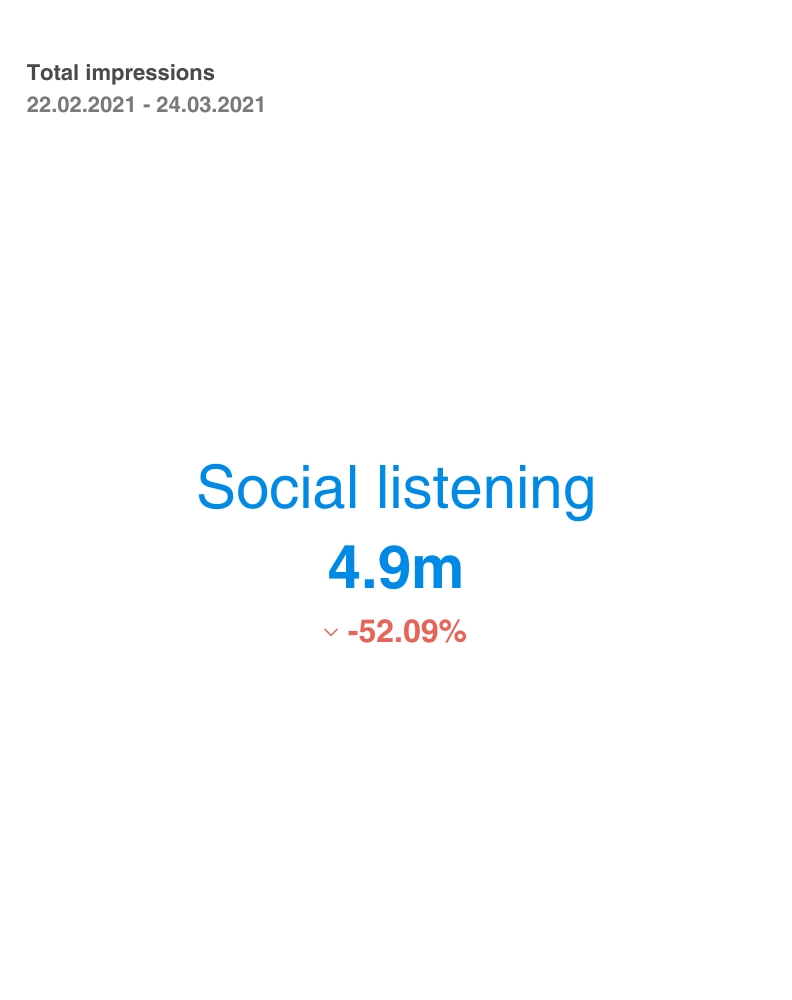
How to better understand impressions in the context of PR metrics
Somehow you’ve collected every mention concerning your brand posted on the internet, but you’d like to understand the impressions better to have more value.
With Determ, you can use three types of ratios to compare the information you have and analyze exactly what you need: share of impressions, total impressions per share, and mentions over time for multiple queries.
Are you ready to rock your PR strategy?
Digital marketing opens new paths to reach your target audience more precisely and optimize your marketing budget better. However, it will only give you desired results if you are aware of your actions, analyze them, and optimize accordingly. To have a complete understanding of your customers, competitors, and the market in general, media monitoring is what you need.
Are you following the PR metrics mentioned in this article? If you’d like to implement them and check if they work for you, book a demo and our experts will take it from there.



